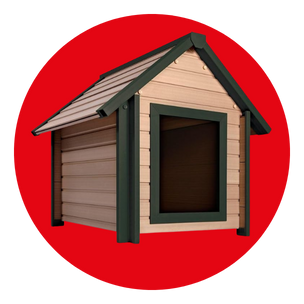What’s the best type of dog kennel for cold weather in Ireland?
+
For Ireland’s damp and cold winters, an insulated dog kennel is ideal. Look for kennels with insulation panels or double walls. Wooden kennels tend to have natural insulation (especially if they’re thick and treated), and you can add door flaps or windbreaks to keep out drafts. Fully insulated, weatherproof kennels ensure your dog stays warm. Additionally, raising the kennel off the ground (on legs or a pallet) prevents cold damp seeping in. In very cold conditions, you might add a heated pad or extra bedding, but always ensure proper ventilation.
How do I choose the right size kennel for my dog?
+
Sizing is crucial for your dog’s comfort. A simple rule of thumb: the kennel should be about 1.5 times your dog’s length and about as wide as 2 times your dog’s width. Your dog should be able to stand up, turn around, and lie down comfortably inside. If the kennel is too small, your dog will be cramped; too large and it may have trouble staying warm in colder weather. Measure your dog’s height and length—for example, if your dog is 60cm tall at the shoulder, the door height should be around 48cm (about 0.8× shoulder height) so they can enter without crouching. We label our kennels Small, Medium, Large, etc., with guidance on which breeds fit each size. When in doubt, choose slightly bigger and add extra bedding for coziness.
How do I install a dog flap door for my pet?
+
Most dog door flaps come with installation instructions and templates. Generally, you’ll need to cut an opening in your door (or wall) to the dimensions of the flap, then fit the dog door frame into it. For a wooden or PVC door, this can be a DIY job with a drill and jigsaw (following the product template). The frame typically screws together to clamp onto the door. Many dog flaps are designed to fit standard thickness doors; if installing in a wall or glass, you may need a professional or a special installation kit. Always install the flap at an appropriate height—usually such that the base of the flap is about your dog’s belly height. This makes it easy for them to step through. If you’re unsure, consult a handyman or glazier (for glass doors). Proper installation will ensure the dog door is secure and weather-tight.
Is insulation important in a dog kennel?
+
Yes, especially for outdoor kennels in Ireland’s climate. Insulation helps regulate temperature, keeping the kennel warmer in winter and cooler in summer. If a kennel isn’t insulated, you can add foam boards or insulating liners, and use straw or thermal blankets as bedding. An insulated dog house can make a big difference in your dog’s comfort; your dog will certainly thank you during chilly nights. Even indoor kennels/crates can be made cosier with crate mats or covers. Just ensure any insulation or covering still allows ventilation. Remember, a well-insulated kennel paired with a flap door will keep warmth in while still letting your pup come and go freely.
What kind of kennel is best for small dogs?
+
Small dogs often feel more secure in a somewhat compact, cozy space. For a small breed, you don’t want an overly large kennel—they should be able to curl up comfortably and the enclosed space will help trap their body heat. A plastic kennel (sometimes called a “pet carrier” style) can work well for small dogs, as it’s lightweight and enclosed. Many small dog owners also opt for indoor kennels or crates that double as a den. If using it outdoors, ensure it’s insulated or add warm bedding, since small dogs can get cold quickly. Some kennels marketed for small dogs have lower door thresholds and shallower height, which can be easier for a tiny dog to use. Always check the dimensions against your dog’s size. And if your small dog is a chewer, choose a sturdy material (heavy-duty plastic or wood) that they can’t gnaw through. Ultimately, the best kennel for a small dog is one that is appropriately sized, weather-proof, and placed in a sheltered location—and of course, filled with soft blankets to make it inviting!








